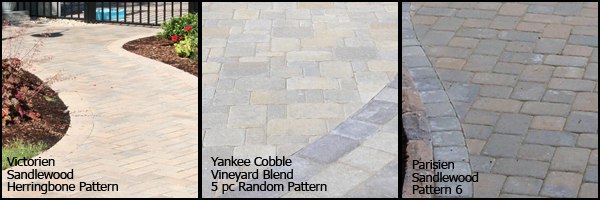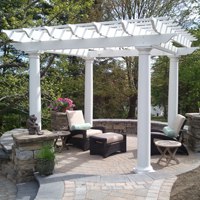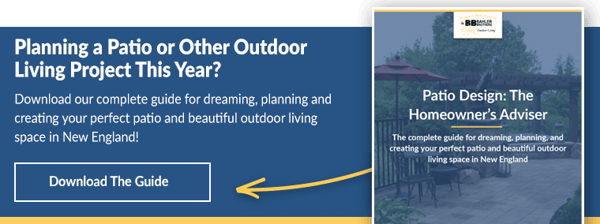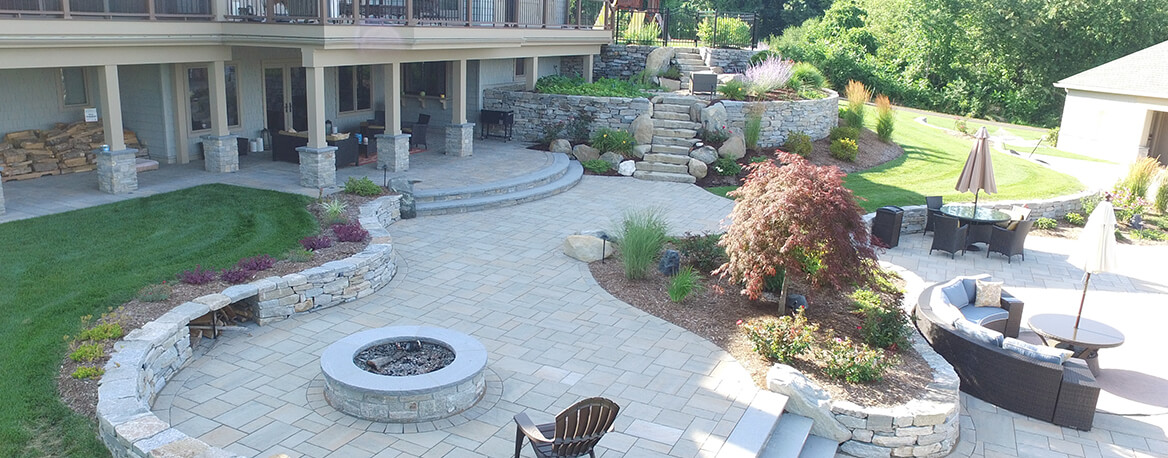
By: Jen Kloter on March 20th, 2012
Patio Design Basics - Considering 4 Different Design Techniques
Outdoor Living | Pavers | Project Design | Patio Design
The other day I was reading through some literature that I received at a trade show or seminar given by one of the paver manufacturers in our area and discovered this great little booklet called Design Basics. It was put together by Belgard Hardscapes, and the more I read of it the more I found that hey, this is exactly how we try to work through the design of a project with our customers. So here's some of what the booklet had to say...
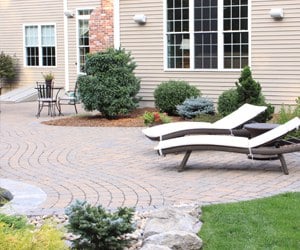 Design Basics
Design Basics
Bringing your backyard patio design dreams to life begins with making a few basic decisions based on what kinds of activities take place there and how each space will accommodate them. You'll want to think about your own personal likes and preferences and how they will impact your design.
- USE YOUR STRENGTHS. Every property and house has good points and things that need to be minimized. Take advantage of the the good things - certain architectural accents or angles should especially be considered and possibly be incorporated in the design.
- BEGIN AT FOCAL POINTS. Extend visual lines from your home's corners, doors, windows to create shapes that help the architecture blend and relate to the design of the patio or walkway.
- BREATHING ROOM. Your patio is basically an outdoor room, so when designing it begin to think about the furniture you will have there. The size of it matters, of course in how big of a space it physically needs... but what about the space you need to use it and comfortably move around it. Your patio table may be 3 feet wide, but you will probably need an additional 3' on all sides in order for someone to be able to sit at the table and you to be able to move around them without walking into the landscape bed beside the patio. And that's just one example.
- VISUAL CONNECTIONS. There are connections that we make between areas, just with our eyes - visual links and sight lines, if you will. Organizing a patio design around a visual axis - like the sight line from your patio door or kitchen window - can give a patio area a very pleasing design with a strong visual interest.
Color.jpg?width=500&name=Multi-Level%20Patio%20with%20Curved%20Steps%20(1).jpg)
Don't be afraid of color. There's not a lot of mystery to figuring it out - it just takes some consideration and planning before hand. Working in harmony with what you already have in your yard is the key. Resist the urge to have everything match perfectly. A brick house may look better with a blend of grey pavers. While brick colored pavers will add warmth to a wood or stone house, they may clash with a brick house. Avoid a monotonous outdoor living space by choosing pavers and wall materials with blended colors.
- TONES IN STONES. Choose pavers with similar tones for a coordinated effect. Light colors reflect light and open up an area, whereas darker tones absorb light and make areas appear smaller.
- BLENDED IS BETTER. Most paver manufacturers have products with palettes of blended colors - multiple colors blended together to give an area of pavers a varied look of greater interest.
- FOLLOW THE SUN. When designing an area, it's wise to consider where the sun hits, how long it stays sunny in that location, and how much shade is being cast there. Do you want to make that area look larger or smaller?
- THE DESIRED EFFECT. Knowing beforehand what specific effects you are striving for is critical to choosing the best paver color blends to suit your home. Should the area blend in calmly to create a subdued appearance, or do you prefer the area to appear more vivid to spice up subdued surroundings?
Shape, Pattern and Texture
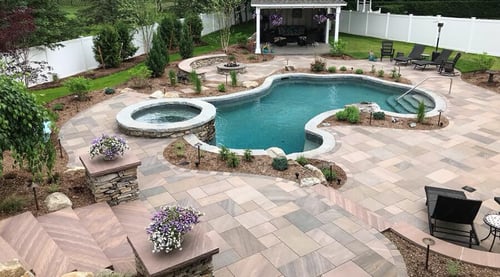 Shapes, patterns and textures of the actual pavers or stones selected can often suggest and accent the use of the installation. They can also be used to repeat certain architectural features, like curved windows and arches, in the patio design to strengthen the connection between the house and patio or walkway.
Shapes, patterns and textures of the actual pavers or stones selected can often suggest and accent the use of the installation. They can also be used to repeat certain architectural features, like curved windows and arches, in the patio design to strengthen the connection between the house and patio or walkway.
- RUNNING PATTERNS. Narrow spaces, like paths and alleyways, can appear wider by laying a pattern on the diagonal or in rows across the area. Likewise, wide spaces can seem narrower by running long shaped pavers the length of the area. A running bond pattern in a curved walkway will bend with and highlight those curves.
- MODULAR AND RANDOM PATTERNS. Large expanses require greater visual interest and provide a great opportunity to let your imagination run free. Where a running pattern in a large area, like a patio, can be visually boring, a modular or random pattern helps to break up a space and give it a little bit of flair.
- TEXTURE ENHANCED. Pavers are available in a natural embossed texture, an antiqued texture or in a smooth or classic finish. Adding multiple textures to your hardscape design can add even more visual interest.
- WEED PREVENTION. Polymer additives and other similar technology has revolutionized the paver and hardscape industry with a sand that stays in the joints between stones and hardens up when it's dry so that weeds have a difficult time growing. When the poly sand gets wet, it will flex and form to the space it's installed in. For more info on Polymeric Sand, click here.
Outdoor Rooms
- COMFORT FOR 2 OR 20. Your outdoor living space shuold easily accommodate the number of people you typically entertain, yet also feel intimate when it's just you and a glass of iced tea.
- FUNCTIONALITY. Your patio should serve a purpose. Simply put, it should be more than just a place to leave a pair of muddy shoes or lawn tools. Make it work with a floor layout that flows and furniture that functions.
- STRIVE FOR HARMONY. A patio or sitting area should serve as the seamless transitional space between your house and garden areas. Think of it as part of the total package and not as a secondary feature.
- SPACE IS THE PLACE. While you can overbuild an outdoor space, it's more typical to under build. Thinking in terms of spaciousness is paramount. You're going to love living outdoors once your project is complete, so plan an area you, your family and guests can really stretch out in and enjoy.
This article may be a little long, but there was so much info in that little book that I thought would be valuable to you when you're designing your patio, so I decided to include it all.
Related topics:
Other articles about Patio Design



